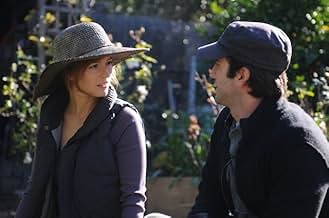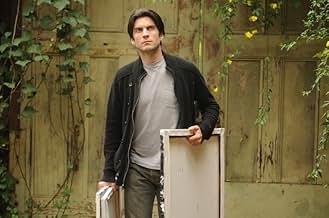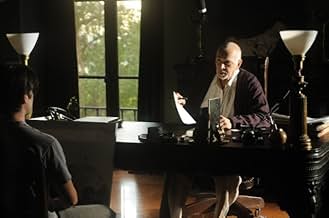Agrega una trama en tu idiomaA struggling young artist meets a mysterious and wealthy benefactor, who offers him a series of increasingly bizarre surveillance assignments.A struggling young artist meets a mysterious and wealthy benefactor, who offers him a series of increasingly bizarre surveillance assignments.A struggling young artist meets a mysterious and wealthy benefactor, who offers him a series of increasingly bizarre surveillance assignments.
- Dirección
- Guionistas
- Elenco
- Premios
- 1 premio ganado en total
- Dirección
- Guionistas
- Todo el elenco y el equipo
- Producción, taquilla y más en IMDbPro
Opiniones destacadas
Beautiful photography, beautiful paintings, beautiful filming! But I am afraid if someone doesn't have an intuitive sense or educated background in seeing and comprehending coloration, a sense of space, composition, contrast, texture, and just plain contemplation of beauty; then I do not feel they will appreciate this film.
From start to finish every frame, scene, setting, motion, etc. of this film is art - fine art. The plot line is secondary to the imagery! Frank Langella as Warner Dax, and Wes Bentley as Daniel are both suffering and failing. Warner Dax suffers the alienation of his family and his declining health. Daniel suffers the inability to provide for his family because his art is failing to sell and his marriage is dissolving. They each escape this suffering through their creative abilities in their own way. Warner hires Daniel to assist him in creating his final painting, but Daniel does not realize this. And Daniel, through his association with Warner finds his way back into his art. The story is easy to follow. What's difficult is seeing how the paintings are an outer expression of their internal selves!
The end credits in the movie states original paintings created by Eric Zener and Stephen Wright. I would love to see an exhibition of the paintings created for this film. And I would love to see an exhibit of just some motion picture stills! The two actors are just shadows behind the art.
I'm giving it an 8 because it's beautiful to watch & see. The acting is a bit dry and you just don't care about them.
From start to finish every frame, scene, setting, motion, etc. of this film is art - fine art. The plot line is secondary to the imagery! Frank Langella as Warner Dax, and Wes Bentley as Daniel are both suffering and failing. Warner Dax suffers the alienation of his family and his declining health. Daniel suffers the inability to provide for his family because his art is failing to sell and his marriage is dissolving. They each escape this suffering through their creative abilities in their own way. Warner hires Daniel to assist him in creating his final painting, but Daniel does not realize this. And Daniel, through his association with Warner finds his way back into his art. The story is easy to follow. What's difficult is seeing how the paintings are an outer expression of their internal selves!
The end credits in the movie states original paintings created by Eric Zener and Stephen Wright. I would love to see an exhibition of the paintings created for this film. And I would love to see an exhibit of just some motion picture stills! The two actors are just shadows behind the art.
I'm giving it an 8 because it's beautiful to watch & see. The acting is a bit dry and you just don't care about them.
a great actor. a strange subject. nuances of atmosphere. all as bones and flesh of a movie who can remember Lucian Freud art or American Beauty.it is a film from images and silence. a kind of parable. or only a lesson.Frank Langella is the locomotive of this interesting project. Sarah Paulson - the delicate spice.Wes Bentley- only a silhouette lost in middle of details. it is a beautiful movie. not exactly good. only beautiful. a kind of embroidery, a precise puzzle, a story about choices, maybe, version of Faust pact. the best ingredient - expectation of viewer. the worse - hope to remark Wes Bentley in a special role. but director intuition remains remarkable - Frank Langella is the best and the others, including the script, may be his mirrors.
The only good performance in this movie is Frank Langella. And there are much better films of his to watch. This one reminded me of a student film shot by a film student with little to no talent. The script is mediocre at best. The performances are wooden. There's nothing special about the cinematography. All in all just a big time waster. Its the kind of independent film TV actors make when the show they're making a living off of is on hiatus and they don't want to sit around doing nothing. There is honestly nothing to this film. Its 85 minutes of actors going through the motions. And the actor who played the artist is probably one of the most uninspriring actors of all time. Maybe if we were still in the silent film era a good director could get a good performance out of him just focusing on his eyes. But once he opens his mouth and starts talking. Ugh.
The Time Being is a meditation and a gentle character study. The director manages to capture a mood without too much dialogue. Frank Langella is as usual masterful in the role of a dying man who commissions a down-on-his-luck painter (Wes Bentley), sending him on strange assignments filming sunrises, sunsets and children playing in a playground. The mystery eventually reveals itself leading the painter to seek balance between his family life and his art. The visuals and production design are stunning as are the transitions of swirling paint in water. I saw this film at the Toronto Film Festival and the audience response was very positive. This is an art-house film that won't disappoint.
Many years ago, a women's magazine featured a list of the sort of men women should avoid marrying. Heading that list were artists. The reason given was that artists marry to take care of all the basic and mundane things in their lives (possibly including sex) so that they can get on with what they really want to do - their art.
Although the article was slightly tongue-in-cheek, this beautifully made film bears the theory out perfectly.
Daniel (Wes Bentley), a struggling artist is having trouble supporting his family. When he delivers a painting to Warner Dax (Frank Langella), a wealthy old man he thinks could become a benefactor, his life undergoes a remarkable change.
At first, Warner commissions him to undertake a series of bizarre surveillance exercises, which seemingly have little to do with art. We suspect that there could be a malevolent motive behind this, especially when Daniel loses his job, and nearly his family. Eventually everything drops into place and we see that rather than a sinister figure, Warner is actually a mentor who offers Daniel a chance to lead a more satisfying life.
Apparently the film was made on a ridiculously small budget, but it doesn't show; low key and moody, the story unfolds at a measured pace.
The art in the film is woven into the texture of the story in a unique way. There is one painting of Warner Dax against a background of brambles, which makes a salient point about how the character sees his life. The names of the artists who executed the powerful paintings in the film appear in the end credits: original paintings created by Eric Zener and Stephen Wright.
Love of art shows through in every frame of "The Time Being", including the atmospheric score by Jan A.P. Kaczmarek. In an interview, writer/director Nenad Cicin-Sain said that in his youth he had been involved in various forms of art, "When I was in my late twenties I formed a partnership with a painter who was ultimately one of the people who did a lot of the paintings in the film, underwater painting".
Presumably this was Eric Zener who provided the art for Wes Bentley's character. The bold figure work we see a little later in the movie, some of which seems like a modern take on the paintings of Lucien Freud, is by Stephen Wright. It's also worth noting that during the painting scenes, the actors seem to know their way around a brush and canvas, applying the paint in a convincing manner.
"The Time Being" celebrates the art of film as much as the impressive artwork within the story. It is a movie that sneaks up on you; I was sorry when it ended. Those who don't normally go for this sort of thing may find it a welcome change of pace.
Although the article was slightly tongue-in-cheek, this beautifully made film bears the theory out perfectly.
Daniel (Wes Bentley), a struggling artist is having trouble supporting his family. When he delivers a painting to Warner Dax (Frank Langella), a wealthy old man he thinks could become a benefactor, his life undergoes a remarkable change.
At first, Warner commissions him to undertake a series of bizarre surveillance exercises, which seemingly have little to do with art. We suspect that there could be a malevolent motive behind this, especially when Daniel loses his job, and nearly his family. Eventually everything drops into place and we see that rather than a sinister figure, Warner is actually a mentor who offers Daniel a chance to lead a more satisfying life.
Apparently the film was made on a ridiculously small budget, but it doesn't show; low key and moody, the story unfolds at a measured pace.
The art in the film is woven into the texture of the story in a unique way. There is one painting of Warner Dax against a background of brambles, which makes a salient point about how the character sees his life. The names of the artists who executed the powerful paintings in the film appear in the end credits: original paintings created by Eric Zener and Stephen Wright.
Love of art shows through in every frame of "The Time Being", including the atmospheric score by Jan A.P. Kaczmarek. In an interview, writer/director Nenad Cicin-Sain said that in his youth he had been involved in various forms of art, "When I was in my late twenties I formed a partnership with a painter who was ultimately one of the people who did a lot of the paintings in the film, underwater painting".
Presumably this was Eric Zener who provided the art for Wes Bentley's character. The bold figure work we see a little later in the movie, some of which seems like a modern take on the paintings of Lucien Freud, is by Stephen Wright. It's also worth noting that during the painting scenes, the actors seem to know their way around a brush and canvas, applying the paint in a convincing manner.
"The Time Being" celebrates the art of film as much as the impressive artwork within the story. It is a movie that sneaks up on you; I was sorry when it ended. Those who don't normally go for this sort of thing may find it a welcome change of pace.
¿Sabías que…?
- Citas
Warner Dax: Well, Daniel, do you have the footage I asked for?
Selecciones populares
Inicia sesión para calificar y agrega a la lista de videos para obtener recomendaciones personalizadas
- How long is The Time Being?Con tecnología de Alexa
Detalles
Taquilla
- Total en EE. UU. y Canadá
- USD 5,274
- Total a nivel mundial
- USD 5,274
- Tiempo de ejecución
- 1h 25min(85 min)
- Color
Contribuir a esta página
Sugiere una edición o agrega el contenido que falta































